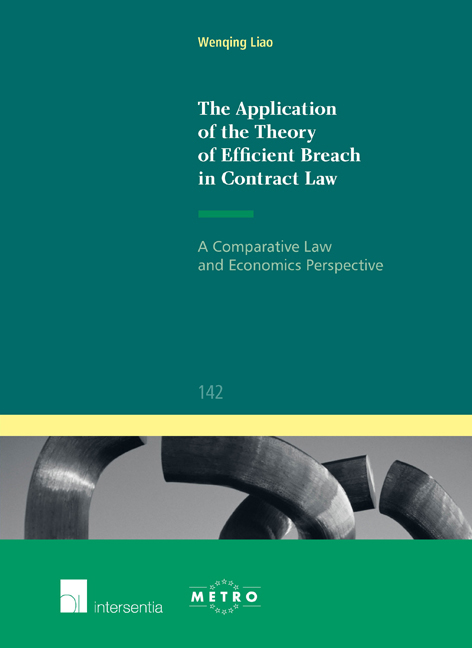 The Application of the Theory of Efficient Breach in Contract Law
The Application of the Theory of Efficient Breach in Contract Law Book contents
- Frontmatter
- Acknowledgements
- Contents
- List of Abbreviations
- List of Tables
- Chapter 1 Introduction
- Chapter 2 Economic Analysis of Contract and Contract Law
- Chapter 3 Efficient Breach in Law and Economics Theory
- Chapter 4 A Re-Examination of the Optimal Rule to Enhance Efficiency
- Chapter 5 Alternative Remedies and Efficient Breach
- Chapter 6 Efficient Breach and European Union Contract Law
- Chapter 7 Efficient Breach and Re-Negotiation in English Sales Law
- Chapter 8 Applying the Efficient Breach Doctrine to Chinese Commercial Sales Law
- Chapter 9 A Comparative Law and Economics Analysis of Efficient Breach in English Law, EU Law and Chinese Law
- Chapter 10 Concluding Remarks and Policy Recommendations
- References
- Table of legislation and European or international instruments
- Cases
- Valorization Addendum
- Ius Commune Europaeum
Chapter 7 - Efficient Breach and Re-Negotiation in English Sales Law
Published online by Cambridge University Press: 12 December 2017
- Frontmatter
- Acknowledgements
- Contents
- List of Abbreviations
- List of Tables
- Chapter 1 Introduction
- Chapter 2 Economic Analysis of Contract and Contract Law
- Chapter 3 Efficient Breach in Law and Economics Theory
- Chapter 4 A Re-Examination of the Optimal Rule to Enhance Efficiency
- Chapter 5 Alternative Remedies and Efficient Breach
- Chapter 6 Efficient Breach and European Union Contract Law
- Chapter 7 Efficient Breach and Re-Negotiation in English Sales Law
- Chapter 8 Applying the Efficient Breach Doctrine to Chinese Commercial Sales Law
- Chapter 9 A Comparative Law and Economics Analysis of Efficient Breach in English Law, EU Law and Chinese Law
- Chapter 10 Concluding Remarks and Policy Recommendations
- References
- Table of legislation and European or international instruments
- Cases
- Valorization Addendum
- Ius Commune Europaeum
Summary
According to law and economics theory, contract law should facilitate transactions and hence promote welfare maximization. In the absence of complete contracts, it is necessary for the system of remedy rules to shape the parties’ incentives to make efficient contracts ex-ante and to act optimally after the contract has been concluded. Accordingly, contract remedy techniques, such as techniques to encourage accurate evaluation, to promote efficient precaution, to avoid performance when it is inefficient to do so and to optimally allocate future risks are desirable. Moreover, contract law may also include particular rules dealing with risks that fall out of the scope of a contract. This chapter will apply the theory of efficient breach to English sales law by analysing its remedy rules and rules in relation to unexpected risks. After a basic introduction to English sales law in section 1, section 2 of this chapter will provide the framework of a buyer's remedies, including the remedy of specific performance, monetary damages and remedies stipulated by contract parties. Afterward, section 3 will analyse the English doctrines of frustration and hardship, which deal with contracts falling into the efficient breach zone. An economic analysis of English law will be made in section 4 in order to examine to what extent a seller is motivated to adhere to the contract as well as to analyse the role of party-autonomy in dealing with breach and performance of commercial sales contracts. Section 5 will conclude.
Introduction to English Sales Law
What we call English sales law mostly refers to the modern law of sales which dates from the end of the 19th century. Before the Sales of Goods Act 1893 (hereinafter SGA 1983), the law of sales basically consisted of common law and a few enactments applying to the general aspect of contracts. Originally, it was the criminal statutes, for instance, rules prohibiting “the use of false measures.or the adulteration of food” that regulated sales transactions and actions on sales were majorly based on deceit, relating to fraud or breaches of express warranty.
- Type
- Chapter
- Information
- The Application of the Theory of Efficient Breach in Contract LawA Comparative Law and Economics Perspective, pp. 167 - 200Publisher: IntersentiaPrint publication year: 2015
